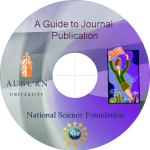

Emerging Journal Formats
There are several new developments in the archival literature. The first, and foremost, is open access, web based journals. These do not appear in hard copy and are only published in an online format. There are pros and cons to this format, and it is an open issue whether established journals with professional publishers will move to the open format. For a beginning academic, as mentioned elsewhere in this CD, it is preferable to publish in mainstream, well known and well respected journals. This will enhance the visibility of your papers. It will also add more value to your C.V.
A second new aspect of journal publishing is a change in the traditional peer review system. While the traditional system has largely migrated to an online, internet based system, the mechanics of the system are unchanged. A hierarchy of editors deals with paper submissions, and finds reviewers, who are almost always anonymous to the paper authors. Another approach to review is an open access review where the submitted paper is posted online for a period of time, and comments are invited from anyone. This review approach has advantages and disadvantages but given the lack of control by both the editors and authors, it is unlikely to prove workable for the majority of papers and journals.
To summarize, while the archival journal system and process is long established and mostly unchanged through the years, there are some new ideas and mechanisms that pop up. You will want to keep abreast of these developments and perhaps participate in them if the opportunity arises. However, for newer academics, it is prudent to keep to established publication outlets and methods.
Emerging issues and technologies in journal publications
(The text in the link is taken from Bell et al., 2007)
Open Access Journals
Open access journals are journals that require no subscription fees. They are freely accessible via the internet. All readers can freely open, read, download or print the articles.
Publishing at open access journals usually have associated costs that are covered by authors' institutions or research grants. Authors retain article copyrights.
The peer review and quality control mechanisms of open access journals are same as the traditional subscription-based journals.
All published open access articles will receive significant reader exposure, including international readership. Thus, the number of citations received is expected to increase.
Article submission information can be found on specific journals' homepages. Submission of an article to an open access journal is done online. Once the author finds a suitable open access journal for his or her research area, the submission and review process will not differ from a subscription based journal.
Some example directories of open access journals can be found online at:
Some articles on open access journals:
"Researchers: Open access great (but not for me)," Industrial Engineer, May 2007, Vol. 5, p. 15
Brown S., "Hot Type.," The Chronicle of Higher Education, 1/19/2007, Vol. 53, Issue 20
Hess, T., Wigand, R.T., Mann, F., Walter, B., "Open Access & Science Publishing Results of a Study on Researchers' Acceptance and Use of Open Access Publishing,", Management Report, 1/2007, Ludwig-Maximilians-Universitat Munich, Germany Institute for Information Systems and New Media, University of Arkansas at Little Rock, USA Department of Information Science
